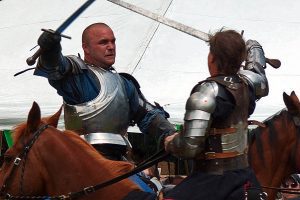 A weapon is more than the damage it deals. In combat, skilled warriors use their weapons to confuse, disorient, and disadvantage their enemies before moving in for the kill. Beyond Damage Dice ties unique maneuvers to weapons from both the core rules and the Midgard Campaign Setting, giving them a distinct impact on the battlefield.
A weapon is more than the damage it deals. In combat, skilled warriors use their weapons to confuse, disorient, and disadvantage their enemies before moving in for the kill. Beyond Damage Dice ties unique maneuvers to weapons from both the core rules and the Midgard Campaign Setting, giving them a distinct impact on the battlefield.
The following maneuvers can be used by any character as long as they are wielding and proficient with the appropriate weapon.
Longsword
Lock Blades. When a creature attacks you with a weapon, you may use your reaction to attempt to lock blades and parry their attack. Make an attack roll with your longsword. You have advantage on this roll if you are wielding your longsword with two hands. If the result of this roll equals or exceeds their attack roll, their attack misses.
Short Draw. As an attack, you may draw a sheathed one-handed sword and make an attack roll to strike the enemy with its pommel, leaving the target gasping for breath. This attack deals no damage, but the next attack roll made against the target has advantage. You must have at least one hand free to take this action.
Shortsword
Close Quarters Combat. When you successfully grapple a creature or escape a grapple, you may make a single attack with a short sword as a bonus action. Additionally, whenever a creature fails to escape a grapple with you, you may make a single attack with a short sword as a reaction.
Short Draw. As an attack, you may draw a sheathed one-handed sword and make an attack roll to strike the enemy with its pommel, leaving the target gasping for breath. This attack deals no damage, but the next attack roll made against the target has advantage. You must have at least one hand free to take this action.
Scimitar
Bloody Wound. When you hit a living creature with a scimitar, you can choose to make a superficial but bloody wound. The attack deals no damage, but the target takes 1d6 slashing damage at the beginning of each of its turns until it makes a DC 10 Wisdom (Medicine) check as an action to stop the bleeding or until it receives magical healing.
Short Draw. As an attack, you may draw a sheathed one-handed sword and make an attack roll to strike the enemy with its pommel, leaving the target gasping for breath. This attack deals no damage, but the next attack roll made against the target has advantage. You must have at least one hand free to take this action.
Rapier
Main Gauche. While wielding both a rapier and a dagger, you may use a reaction after being attacked to roll a d4 and add the result to your Armor Class until the end of the attacker’s turn.
Lock Blades. When a creature attacks you with a weapon, you may use your reaction to make an attack roll with your rapier. If the result of this roll equals or exceeds their attack roll, their attack misses.
Greatsword
Arcing Slash. When you attack with a greatsword, you may choose to target two creatures within your reach with a single attack. This attack uses the same attack roll for both targets and deals slashing damage equal to 1d6 plus your Strength modifier to each target.
Grinding Halt. Whenever you must make a Strength saving throw to avoid being moved against your will, you can dig the blade of your greatsword into the ground as a reaction. Roll 2d6 and add the number rolled to the saving throw. If the effect pushing you does not have a saving throw, you move 5 feet fewer
For more options for player characters, check out Midgard Heroes.

Is Bloody Wound meant to be stackable?
Hm, good question. I’d rule either:
a. No, or
b. Yes, but a single Wisdom (Medicine) check ends all bleeding effects.